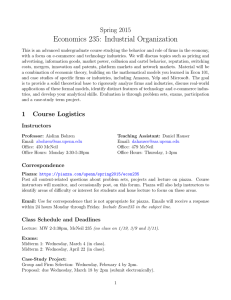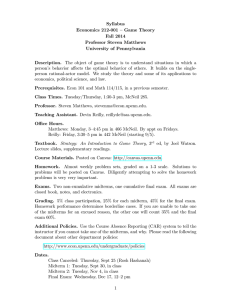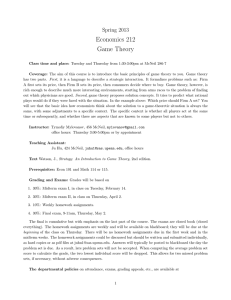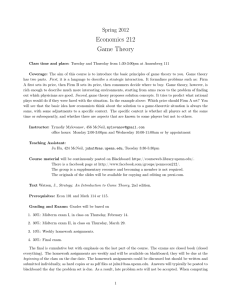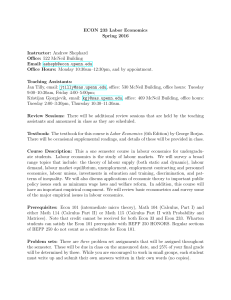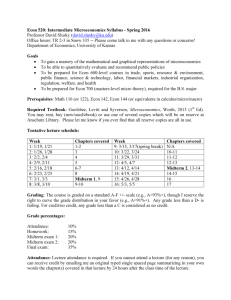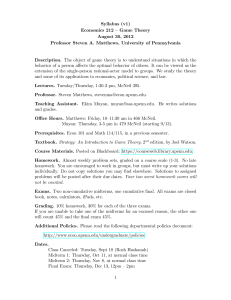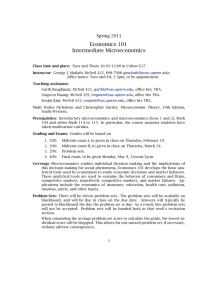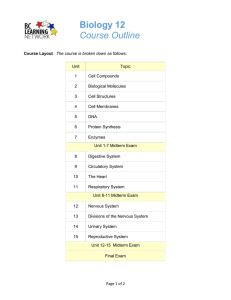Economics 235: Industrial Organization Fall 2015
advertisement
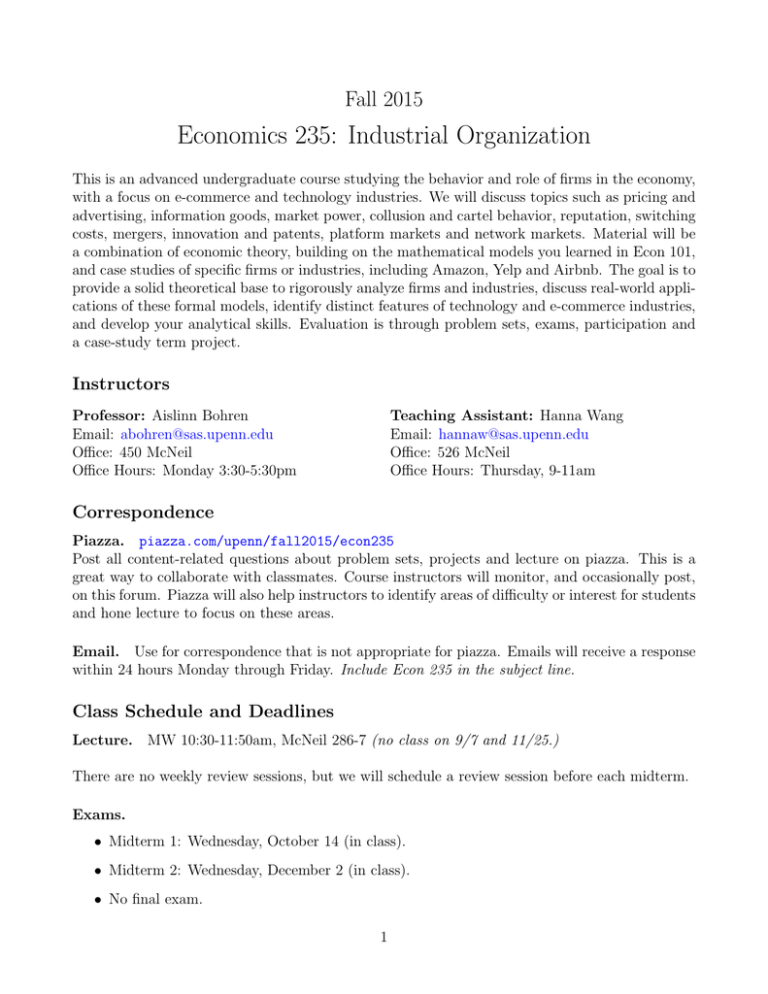
Fall 2015 Economics 235: Industrial Organization This is an advanced undergraduate course studying the behavior and role of firms in the economy, with a focus on e-commerce and technology industries. We will discuss topics such as pricing and advertising, information goods, market power, collusion and cartel behavior, reputation, switching costs, mergers, innovation and patents, platform markets and network markets. Material will be a combination of economic theory, building on the mathematical models you learned in Econ 101, and case studies of specific firms or industries, including Amazon, Yelp and Airbnb. The goal is to provide a solid theoretical base to rigorously analyze firms and industries, discuss real-world applications of these formal models, identify distinct features of technology and e-commerce industries, and develop your analytical skills. Evaluation is through problem sets, exams, participation and a case-study term project. Instructors Professor: Aislinn Bohren Email: abohren@sas.upenn.edu Office: 450 McNeil Office Hours: Monday 3:30-5:30pm Teaching Assistant: Hanna Wang Email: hannaw@sas.upenn.edu Office: 526 McNeil Office Hours: Thursday, 9-11am Correspondence Piazza. piazza.com/upenn/fall2015/econ235 Post all content-related questions about problem sets, projects and lecture on piazza. This is a great way to collaborate with classmates. Course instructors will monitor, and occasionally post, on this forum. Piazza will also help instructors to identify areas of difficulty or interest for students and hone lecture to focus on these areas. Email. Use for correspondence that is not appropriate for piazza. Emails will receive a response within 24 hours Monday through Friday. Include Econ 235 in the subject line. Class Schedule and Deadlines Lecture. MW 10:30-11:50am, McNeil 286-7 (no class on 9/7 and 11/25.) There are no weekly review sessions, but we will schedule a review session before each midterm. Exams. • Midterm 1: Wednesday, October 14 (in class). • Midterm 2: Wednesday, December 2 (in class). • No final exam. 1 Case-Study Project. • Group and Firm Selection: Friday, September 18 by 5pm. • Proposal: due Monday October 26 by 5pm (submit electronically). • Presentations: December 7 (in class) and December 14 (9am-11am - final period). • Paper: due Friday, December 18 by 12pm (submit electronically). Course Material. Text. • Lynne Pepall, Dan Richards and George Norman, Contemporary Industrial Organization: A Quantitative Approach, 1st Edition (on reserve at van Pelt). • Case study readings: https://cb.hbsp.harvard.edu/cbmp/access/39101403 Case studies can be bought as a course packet at a discounted student rate or individually for $7 on the HBS website. Readings. https://canvas.upenn.edu/courses/1295891 I will assign a mix of readings from the textbook, case studies, academic journals, blogs and the news. This reading is required and students are responsible for understanding the material assigned. Aside from the case studies and text, readings will be available online or on JSTOR at no cost. I will post the reading each week on the Canvas homepage. Other material. All other material (lecture notes and slides, problem sets, sample exams) will be posted on Canvas. Check regularly! Check your email settings on canvas to make sure you receive emails. Course Requirements Case Study Project. A main requirement for the class is a case-study term project. The paper portion of the project is due with no exceptions on Friday, December 18 at 12pm. A shorter proposal of what your plan for the project is due Monday, October 26 at 5pm. Students will present their projects during the last week of class and the final exam period. Details on what is expected for this project are provided in the handout “Case Study Project”. Submit as pdf file to abohren@sas.upenn.edu AND hannaw@sas.upenn.edu. 2 Problem Sets. There will be 4-6 graded problem sets, available on canvas and due at the beginning of class on the due date. These assignments will develop your problem solving skills and build the skills you need to succeed on the exams. The assignments can be discussed with classmates, but should be written and submitted individually. Answers will typically be posted to canvas the day the problem set is due. As a result, late problem sets will not be accepted. I will select a subset of questions to grade on each assignment. Submit hard copy in class or pdf file to hannaw@sas.upenn.edu. Exams. There will be two in class midterms (10/14 and 12/2). The exams are closed book (closed everything). I will post a sample midterm about a week in advance. Midterm attendance is mandatory. Students who miss a midterm for an allowable reason must report their absence on the Course Absence Reporting (CAR) System. Participation. Students will receive credit for participation, including lecture participation, class activities and piazza participation. Students will receive extra credit for posting high quality answers on piazza. Grade Breakdown. • Problem Sets: 20% • Midterms: 22.5% each • Case Study Presentation: 10% • Case Study Paper: 20% • Participation: 5% Prerequisites Econ 101; Math 104 & 114 or Math 115. Econ 103 is recommended. Econ 235 assumes that students have taken multivariate calculus and have basic knowledge of probability. A strong understanding of these mathematical tools is crucial to succeed in the course. Course Policies The Economics Departmental Course Policies outline rules about exam attendance, grading appeals, academic integrity, etc. You are responsible for familiarizing yourself with these policies. If you miss a midterm for an excused reason (as specified in the course policies), there will be one cumulative make-up midterm in December. Outline of Topics Below is a list of topics I would like to cover, in the approximate order you will see them. This may be adjusted over the course of the semester to account for time constraints and class interests. In terms of exams, you will not be responsible for material we do not cover. 3 1. Introduction (a) What is a firm? (b) Review: The firm’s problem (c) Market structure: monopoly, monopsony, market power (d) Antitrust Laws 2. Goods, Industries and Competitive Strategy (a) Competitive Advantage and Industry Analysis (b) Internet Markets (c) Information Goods 3. Monopoly: Pricing and Other Strategies (a) Price Discrimination (b) Pricing in Online Markets (c) Product Differentiation (d) Durable Goods and Dynamic Pricing (e) Switching Costs and Lock-in (f) Advertising 4. Strategic Interaction (between firms) (a) Review: Game Theory (b) Static Oligopoly (c) Collusion and Cartels (d) Reputation 5. Contractual Relationships Between Firms (a) Innovation and Patents (b) Mergers (c) Vertical Integration and Restraints 6. Technology Markets (as time allows) (a) Network Markets (b) Platform Markets (c) The Sharing Economy Acknowledgements: I thank Simon Board for his input on the technology and e-commerce components of this course. 4
